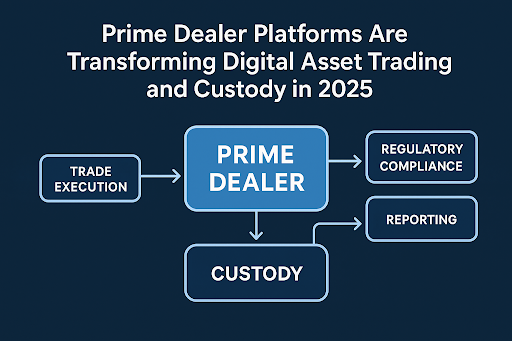When people compare the block size of Bitcoin Cash versus Bitcoin, they often think about it as if they were comparison shopping for a new smartphone.
A 256 GB model has four times the storage of a 64 GB model. That means the 256 model can hold four times as many photos, songs and videos. Similarly, Bitcoin Cash has 8 MB blocks versus Bitcoin’s 2 MB (SegWit) blocks. That means Bitcoin Cash can process 4x as many transactions as Bitcoin, and therefore, Bitcoin Cash has better technology than Bitcoin — so the thinking goes.
However, that line of thinking stems from a fundamental misconception about what block size means to bitcoin. Whereas storage capacity on a phone hits up against physical limitations on how many memory cells can be crammed onto a tiny chip, block size in bitcoin is a customizable limit that can be raised or lowered based on consensus from the nodes in the network.
--- a/trunk/main.h +++ b/trunk/main.h @@ -15,6 +15,7 @@ class CKeyItem; static const unsigned int MAX_SIZE = 0x02000000; +static const unsigned int MAX_BLOCK_SIZE = 1000000; static const int64 COIN = 100000000; static const int64 CENT = 1000000; static const int COINBASE_MATURITY = 100;
Diff from the 2010 commit adding a block size limit to Bitcoin (via Sourceforge)
In that sense, block size is more policy than it is technology. And like policy, block size then should be judged, not based on the size of the number in isolation, but on whether it helps each project achieve its policy goals and creates a healthy and growing network.
- Bitcoin Cash’s goal is to create electronic peer-to-peer cash — aka PayPal 2.0 — so bigger blocks should increase transaction throughput via on-chain scaling and improve user accessibility through lower fees.
- Bitcoin’s goal is to create a store of value — aka digital gold — so its blocks should enable its use as a settlement network via off-chain scaling and prevent censorship through decentralized ownership of the network.
Evaluating those blockchains, then, doesn’t mean comparing 8 MB versus 2 MB like specs on your phone. It’s understanding how block size feeds into the bigger vision for where the coin wants to go and how it plans to get there.
Where the block size limit comes from
Prior to mid-2010, Bitcoin had no block size limit. Bitcoin founder Satoshi Nakamoto introduced it in July 2010 without fanfare or discussion. According to early Bitcoin contributor Michael Marquardt (aka theymos), the block size limit was a policy choice to “solve an obvious denial-of-service attack vector.”
Without a block size limit, a rogue miner could create large blocks filled with micro-transactions — let’s say 1 GB blocks with 2,000,000 transactions of 0.00000001 BTC each — which would force nodes to download, upload and store large amounts of data, leaving them unavailable to confirm legitimate transactions.
This would be an especially acute problem for smaller nodes consisting of regular people helping validate transactions and make the Bitcoin network work. The block size update put an upper limit on the Bitcoin network’s throughput so that it fit comfortably within 2010-era storage and bandwidth available to these regular people.
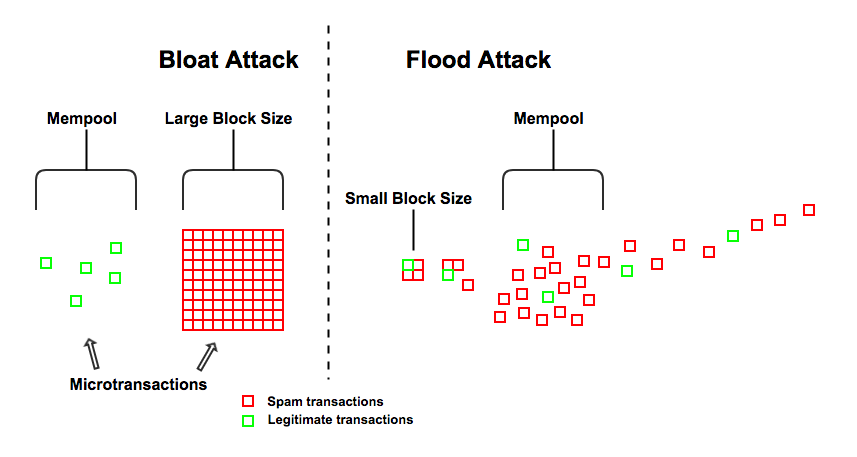
Limiting the block size opened the door to another type of Denial-of-service (DoS) attack, however — the flood attack. With throughput in the Bitcoin network limited by block size, an attacker could substitute volume for size. By sending thousands of smaller transactions to the network, they could “flood” the mempool — the pool of transactions waiting for miners to include them into new blocks — and fill new blocks. Because those blocks are limited in size and frequency, legitimate transactions would end up pushed into the mempool. Since transactions with higher fees get prioritized to come out of the mempool first, such a flood attack would mean higher transaction fees for everyone.
In 2010, flood attacks didn’t matter because blocks were near empty. No one was using Bitcoin. But as usage continued to increase the 1 MB blocks began to get flooded and filled with legitimate (and spam) transactions. The block size debate formed around these two attack vectors and the tradeoffs required to prevent them.
- Bigger blocks allow more transactions to be processed per second but require better hardware to process them.
- Smaller-sized blocks make it easy for anyone to run a node with the tradeoff of slower transaction speeds and higher fees for transacting on the network.
Over time, the debate became so contentious that it resulted in the bigger block proponents to fork the Bitcoin blockchain into Bitcoin Cash. Bitcoin represents the choice of smaller-sized blocks plus SegWit, which sets the stage for scaling off-chain.
Faster transaction speeds via bigger blocks
Faster transaction speeds and lower fees makes a network more valuable. But Bitcoin Cash’s faster transaction speeds and lower fees today are more of a product of its lack of adoption compared with Bitcoin than its bigger blocks.
Bigger blocks enable faster transaction speeds in theory, but in practice, the bigger block sizes aren’t making a difference yet. While Bitcoin Cash’s maximum block size is 8 MB, the average actual block size typically ranges between 250k and 0k, or less than 3% of capacity.
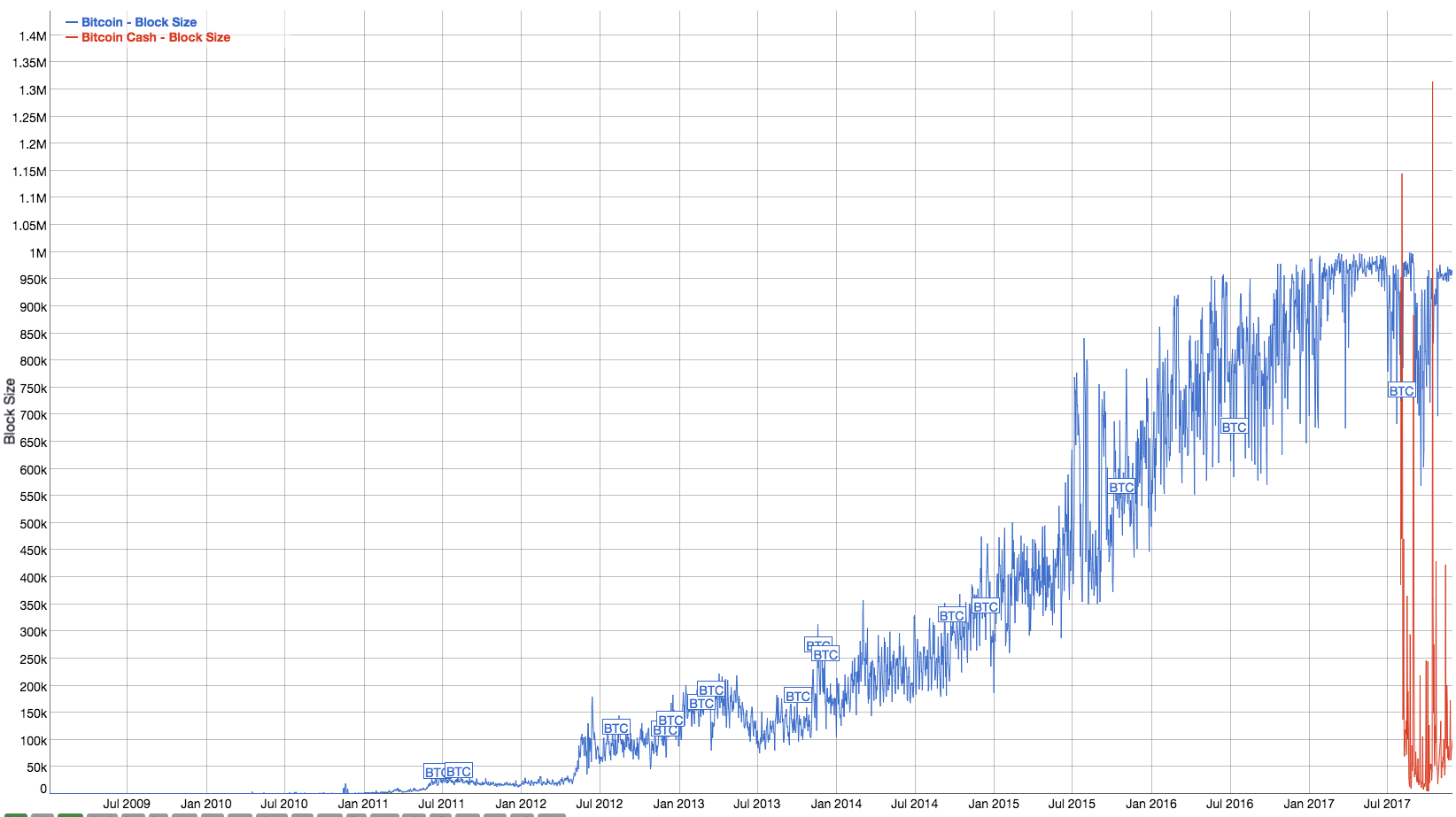
That’s why Bitcoin Cash’s maximum transaction rate isn’t valuable in itself — because the network is operating at a small fraction of its capacity and of Bitcoin’s capacity. It’s the solution to a problem that Bitcoin Cash doesn’t have.
Bitcoin, on the other hand, has been hitting up against its 1 MB legacy block size limit as of early 2017. Those full blocks have caused the Bitcoin daily transaction volume to have plateaued over the past year.
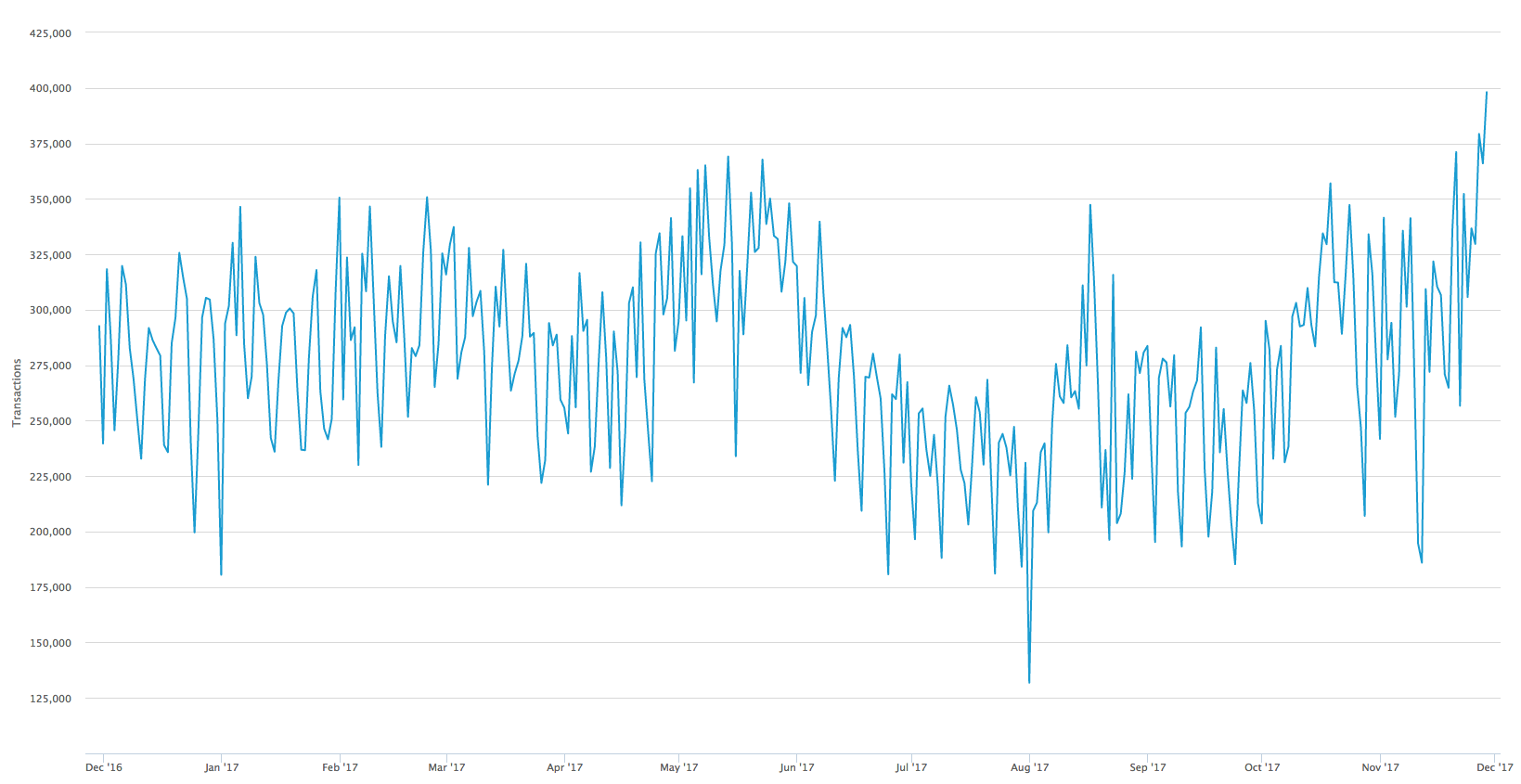
At the same time, the mempool of backlogged transactions has grown, which means longer confirmation times and higher fees to pay to get transactions prioritized.
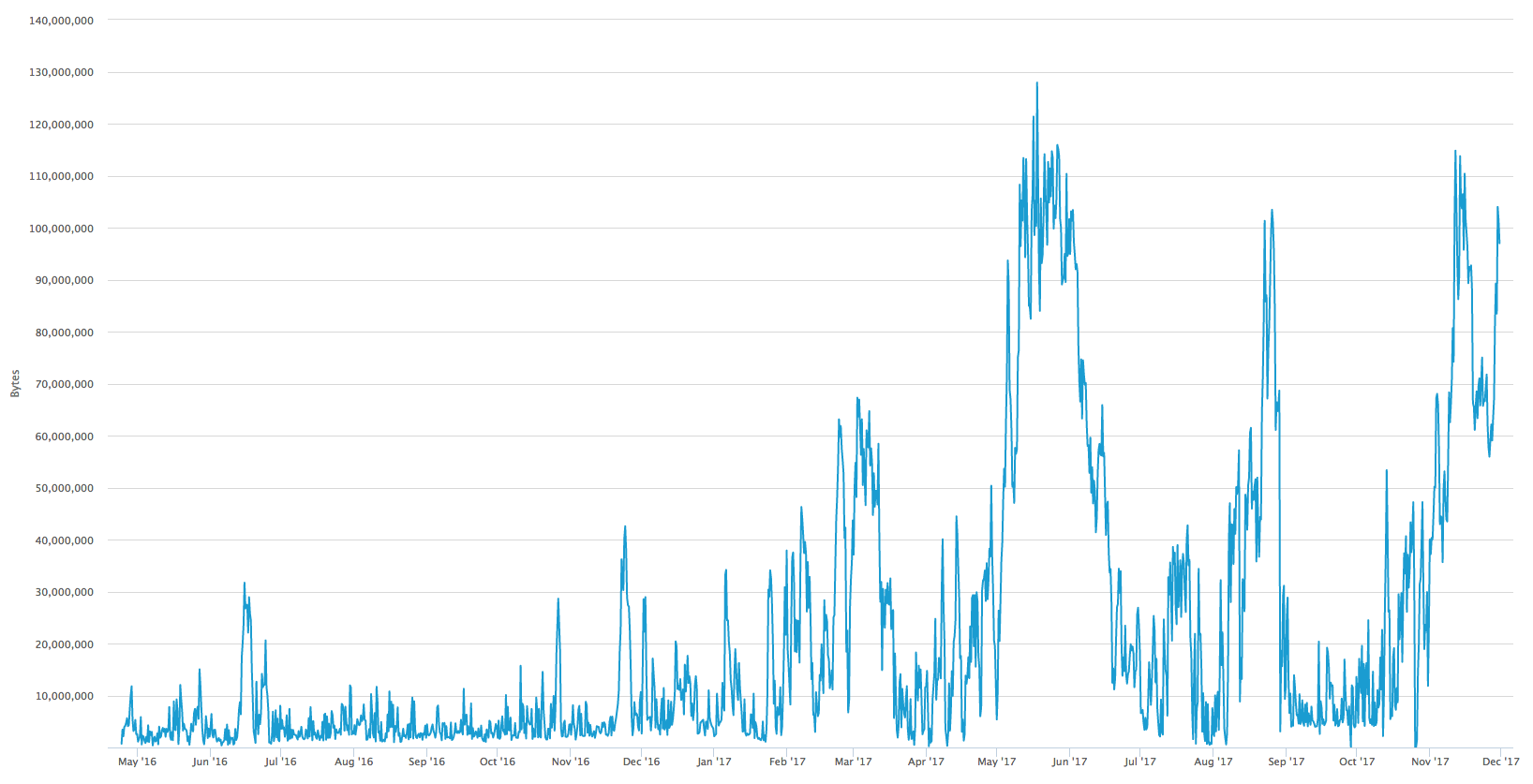
This is a dramatic change from 2010 when the biggest spike in block size hit .02 MB, or 2% of its 1 MB capacity. Now that Bitcoin’s average block size is so close to its capacity, it’s become much more susceptible to flood attacks — which is exactly what some Bitcoin supporters have indicated is happening.

Bitcoin Cash’s bigger block size is a solution to a problem on the Bitcoin network. So its value may be in what it signals about the direction of Bitcoin Cash — positioned against the direction of Bitcoin — rather than in what it has actually done to improve its own network throughput.
- Bigger blocks from the get-go and no SegWit signal that Bitcoin Cash will scale its transaction volume by adopting bigger and bigger blocks.
- Smaller blocks and the adoption of SegWit signal that Bitcoin will scale with layer 2 solutions like payment channels and Lightning network.
One way to think about it is which policy direction will help the chains scale the best, not as an abstract evaluation of 8 MB versus 2 MB block size.
Decentralization via smaller blocks
That bitcoin is decentralized goes to the very core of what makes it valuable. No single entity controls it, so it’s censorship resistant, borderless, and open. Because bigger blocks theoretically threaten Bitcoin’s decentralization, they theoretically threaten Bitcoin’s most core value.
However, since 2010 when block sizes were implemented, mining has changed dramatically, from something that hobbyists did to jumpstart a nascent network, to today where it’s become a billion dollar industry. So while increased centralization has happened, it hasn’t been as a result of bigger block sizes.
Mining today for both Bitcoin Cash and Bitcoin is relatively centralized, with a handful of miners making up over 51% of the hash rate for both.
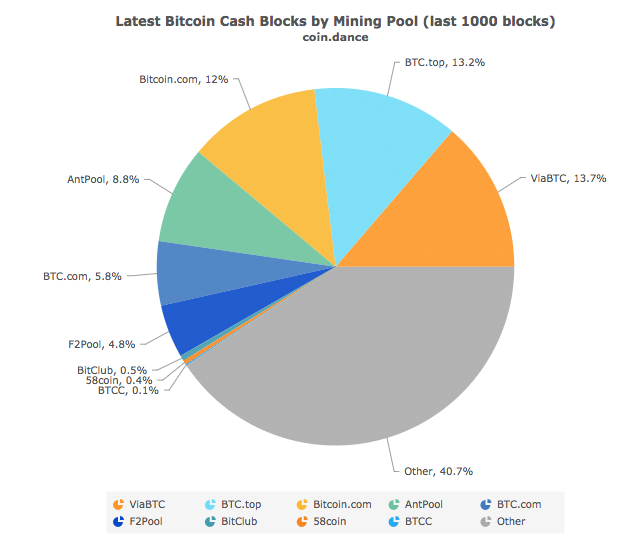
As mining technology progressed from CPUs to GPUs, FPGAs and then ASICs — chips designed specifically to mine Bitcoin — mining became progressively more professional, pushing out hobbyist miners and centralizing mining with the centralization of capital.
In contrast, block size hasn’t been a major driver of centralization. The blockchain size has grown, but it’s still smaller than 150 GB. By comparison, you can buy a consumer desktop computer with a 1 TB hard drive for less than $500.
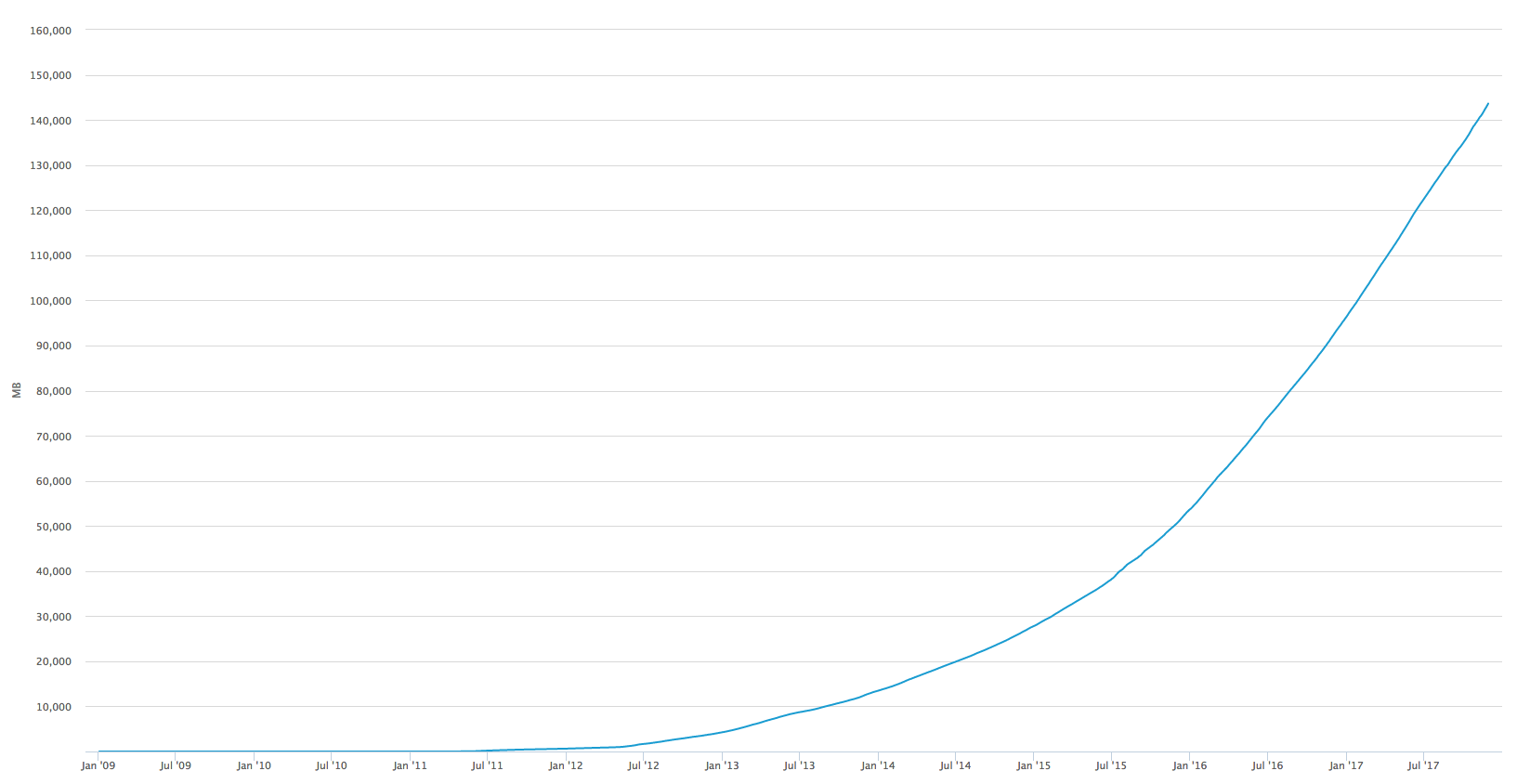
At the legacy block size of 1 MB, the blockchain will grow 52 GB per year.
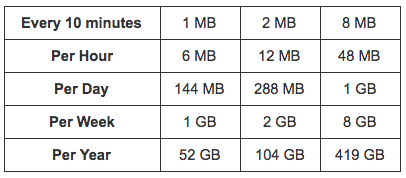
Meanwhile, the cost of disk space and bandwidth have continued to fall from where they were in 2010.
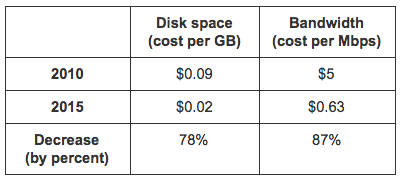
So while some are predicting a re-decentralization of mining, it has to do with hitting the limits of Moore’s Law in terms of how small ASIC chips can be produced (now at 14 nanometers). The processor arms race centralized mining, and its end can put miners on equal footing again.
For now, mining is already centralized. The policy question then with respect to bigger blocks isn’t so much around centralization, it’s more about the allocation of the cost of supporting the bitcoin network and what that means for the ultimate vision for the network.
- Bigger blocks allocate that burden to the miners who need to buy better hardware. That improves accessibility of using Bitcoin Cash to users in the form of lower transaction fees and faster confirmation times, which enables its use for smaller and more frequent purchases.
- Smaller blocks allocate that burden to users who pay higher transaction fees and live with slower confirmation times. Users record transactions on the blockchain infrequently for high-value censorship resistant storage of value or in settlement of off-chain transactions.
This has many people within the Bitcoin community debating which application of bitcoin tech is more valuable long-term, “PayPal 2.0” (Bitcoin Cash) or digital gold (Bitcoin).
Bigger blocks is a bitcoin experiment
Unlike choosing between a 256 GB smartphone and a 64 GB smartphone, 8 MB block sizes aren’t a technological improvement that will get Bitcoin Cash higher transaction throughput on its blockchain today. The 8 MB block size is a policy choice meant to show the coin’s potential as peer-to-peer electronic cash.
Bitcoin was the first cryptocurrency, is currently the biggest cryptocurrency, and is lacking a visible leader. At its size, it will be the slowest moving. A huge challenge for the community will be in finding consensus, improving the technology, and scaling the blockchain to support more users and use cases.
Where Bitcoin can find consensus, it will move toward that vision for the future. Where it can’t, new coins will splinter off to create their own vision for where bitcoin should go. Bigger blocks is an experiment, and whether it succeeds or fails will be valuable information for everyone in the crypto space. And if any forks do succeed, they add users, use cases and knowledge to the entire cryptocurrency ecosystem.
The above references an opinion and is for informational purposes only. It is not intended as and does not constitute investment advice, and is not an offer to buy or sell or a solicitation of an offer to buy or sell any cryptocurrency, security, product, service or investment. Seek a duly licensed professional for investment advice. The information provided here or in any communication containing a link to this site is not intended for distribution to, or use by, any person or entity in any jurisdiction or country where such distribution or use would be contrary to law or regulation or which would subject SFOX, Inc. or its affiliates to any registration requirement within such jurisdiction or country. Neither the information, nor any opinion contained in this site constitutes a solicitation or offer by SFOX, Inc. or its affiliates to buy or sell any cryptocurrencies, securities, futures, options or other financial instruments or provide any investment advice or service.



